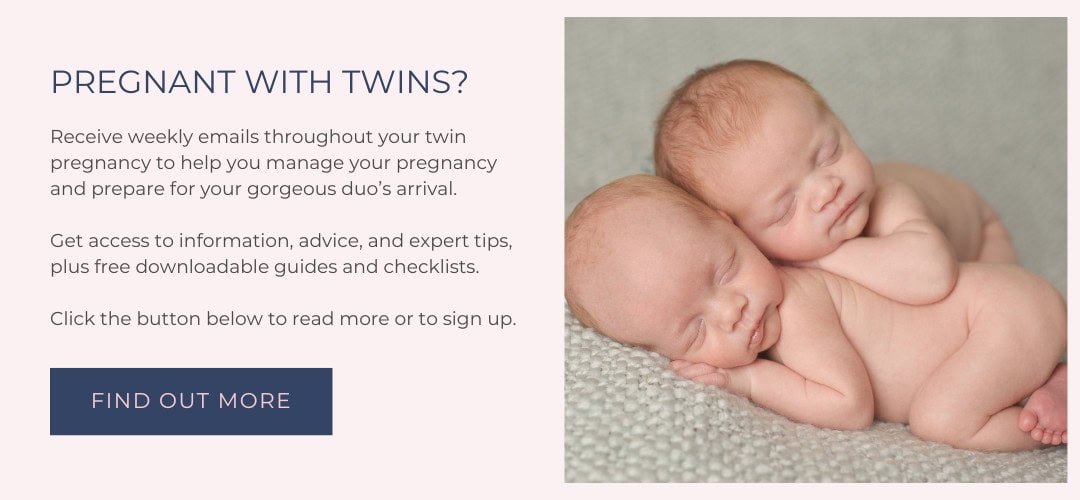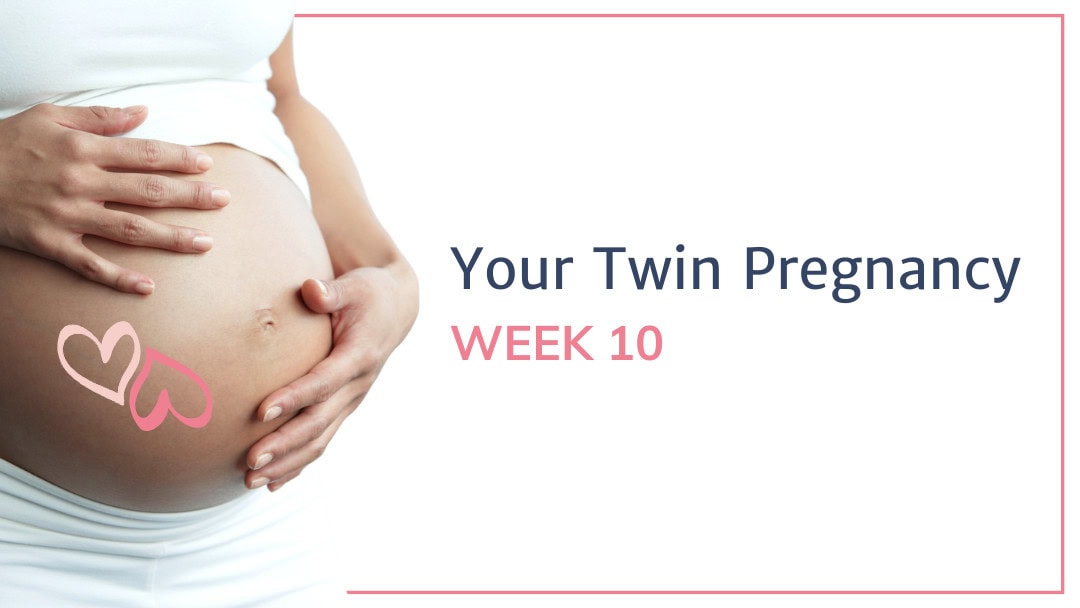Hello, twin mama! You’ve officially made it to week 10, which is such a big milestone—double digits! At this stage, your twin pregnancy is starting to feel more real, both emotionally and physically.
There’s a lot going on, not just in your body but also in your heart and mind as you prepare to meet your two little ones. Whether you’re feeling excited, nervous, exhausted, or all of the above, it’s completely normal.
This week, we’re diving into something that can feel a bit overwhelming—twin terminology. When you found out you were carrying twins, you probably heard some new terms being thrown around—monochorionic, diamniotic, zygotes, fraternal vs. identical—and that can feel like a lot to take in. Don’t worry, we’ll break it all down for you and help you understand what it all means, step by step.
We’ll also talk about starting to bond with your babies, understanding the potential pregnancy challenges associated with different types of twins, and how to manage some of the fatigue you’re probably feeling right about now.

How are you feeling mama?
Twin Pregnancy Symptoms at 10 weeks
At week 10, you might be feeling some of the classic early pregnancy symptoms—nausea, fatigue, and mood swings—but there’s a good chance that because you’re carrying two babies, these symptoms are amplified. It’s totally understandable to feel like you’re running on empty, especially when it comes to energy levels.
Dealing with low energy levels: Twin pregnancies often come with more intense symptoms because your body is working overtime. Those tiny babies are growing fast, and your body is producing extra blood to support them. It’s no wonder you might feel like you need an extra nap or two (or three) during the day.
Take naps whenever possible, eat small frequent meals to keep your blood sugar steady, and stay hydrated. Don’t be afraid to ask for help—whether it’s with household chores or just taking some time to rest. Your body is doing a lot right now, and it’s okay to slow down.
What are your twins up to this week?
Your Twins at 10 Weeks – Height & Weight
At 10 weeks, your twins are each about the size of a kumquat or a small strawberry, measuring approximately 1.2 inches long from crown to rump and weighing around 0.14 ounces. While they’re still quite tiny, they’re growing rapidly—nearly doubling in size from just a week ago!
This marks the end of the embryonic stage, and they’re about to enter the fetal stage, where growth will continue to accelerate. Though their weight is minimal, all the essential structures are forming, preparing them for the significant developments coming in the next few months.
Your Twins Fetal Development at 10 weeks
By now, your twins’ major organs, including the liver, kidneys, intestines, and brain, are forming and starting to function. Their hearts are beating regularly, and they’re even beginning to move, though you won’t feel their tiny kicks just yet.
The head is still quite large compared to their bodies because the brain is growing rapidly, and their facial features—like the eyes, nose, and mouth—are becoming more defined.
Their eyes are closed, but their eyelids are developing, and their arms, legs, fingers, and toes are taking shape. Teeny tiny nails are starting to form, and soon, they’ll be practicing more movements, strengthening their muscles as they prepare for life outside the womb.

What you might be wondering about this week
The Types of Twins: Understanding Twin Terminology
When you’re pregnant with twins, every doctor’s visit seems to introduce a new set of terms. Zygosity, Chorionicity, Amniocity… what does it all mean???
Zygosity
Zygosity means whether twins come from one egg or two eggs, which is how we tell if they are identical or not.
- Identical Twins (Monozygotic): These twins come from a single fertilized egg that splits into two embryos. They share the same genetic material, which is why they look so similar and are always the same sex.
- Fraternal Twins (Dizygotic): These twins come from two separate eggs fertilized by two different sperm. They share about 50% of their genes, just like any other siblings, and they can be either the same or different sexes.
Chorionicity
One of the first things your doctor will determine is whether your twins are monochorionic or dichorionic, which refers to the number of placentas they have. This is important to know as it will determine the care you should receive during your pregnancy.
- Monochorionic Twins: These twins share a single placenta, which is more common in identical twins. This type of pregnancy requires closer monitoring because of the higher risk of complications like twin-to-twin transfusion syndrome (TTTS).
- Dichorionic Twins: These twins each have their own placenta. This is typically seen in fraternal twins but can also occur with identical twins if the egg splits early in the process.
Amnionicity
Next, there’s the term amnionicity, which refers to whether your twins share the same amniotic sac (the fluid-filled space where the babies grow):
- Monoamniotic Twins: These twins share both a placenta and an amniotic sac, which is quite rare and requires very careful monitoring due to the risk of the babies’ umbilical cords becoming entangled.
- Diamniotic Twins: These twins each have their own amniotic sac, which is the most common situation and is generally safer.
How Twin Zygotes Develop
The development of your twins started at conception, and the journey of how their zygotes (fertilized eggs) formed is pretty fascinating:
- For identical twins (monozygotic), a single egg was fertilized by one sperm and then split into two embryos. This process can happen at different stages, which determines how much your twins share—whether they have separate or shared placentas and amniotic sacs.
- For fraternal twins (dizygotic), two eggs were released and each was fertilized by a different sperm. These twins each develop their own placenta and amniotic sac, making their pregnancies a bit less complicated than identical twins.
Why a Twin Pregnancy is considered a High-Risk Pregnancy
One thing many twin moms are surprised to learn is that all twin pregnancies are considered “high risk.” This doesn’t mean something will go wrong, but it does mean your healthcare team will keep a closer eye on you and your babies throughout the pregnancy.
Because twins are more likely to be born early, develop growth issues, or experience complications like TTTS, you’ll have more frequent ultrasounds and check-ups to ensure everything is on track.
Pregnancy Challenges by Twin Type
Depending on whether your twins are identical or fraternal, there may be some specific challenges ahead:
- For identical twins: There’s a slightly higher risk of complications, especially if your twins are sharing a placenta or an amniotic sac. Conditions like TTTS or growth discordance (where one twin grows faster than the other) can occur, so your doctors will keep a close watch.
- For fraternal twins: While fraternal twins have fewer complications in pregnancy compared to identical twins, there’s still the potential for one baby to grow faster or be positioned differently, which can affect delivery. Fraternal twins can also have quite different personalities or temperaments, which is something to keep in mind as they grow!
In our 11 Weeks Pregnant with Twins article, we discuss some of the complications you need to be aware of in more detail.
Bonding with Your Babies
Now that we have got all the serious stuff out of the way, let’s not forget that you have two beautiful babies growing inside you, that I know you can’t wait to meet.
Even though it’s still early, you can start bonding with your twins now! It might feel a bit surreal since you haven’t felt them moving yet, but there are ways to connect emotionally:
- Talk to your babies: Even though they can’t hear you yet, speaking to them or singing softly can help you start to build that connection. It will give those vocal chords some practice singing all those bedtime lullabies that you will come to know and love once your delicious duo arrives.
- Visualize holding them: Imagining what it will feel like to hold them, what their little faces will look like, and how it will be to have them in your arms can be a powerful bonding exercise.
- Keep a journal: Documenting your pregnancy journey and how you’re feeling as you prepare for twins can help you process your emotions and get excited about the new chapter in your life. And it is SUPER special to look back on in years to come.
Wrapping Up Week 10
You’re now well on your way through the first trimester, and it’s exciting to think about how much your babies have grown in just a few weeks! Hopefully this Twin Pregnancy Series is helping you to learn about your pregnancy and your babies – it’s such an important part of preparing for the journey ahead.
Remember, mama, taking care of yourself is the best way to take care of your babies. Rest when you can, ask for help, and don’t hesitate to reach out to your doctor with any questions or concerns. You’ve got this!
Stay tuned for Week 11, where we talk all about your Twin Pregnancy Care Plan and what you can expect as you move into your second trimester where things start to calm down just a little. Hopefully you’ll be feeling a whole lot better soon.
Sending you and your two little ones lots of love and virtual hugs this week!

P.S. Want to receive a reminder email to come back and read the next post in this Twin Pregnancy series? Register for our Twin Pregnancy & Preparing for Twins emails, and it will drop straight into your inbox.


